Fencing Melee
Theories and Thoughts
Don Yngvar the Dismal, OWS, KSCA, Earl AEthelmearc
Introduction
When we think of melee in our Society we think of fighters in armour charging across the fields of Pennsic or Gulf Wars or most events on any weekend. Melee is a very personal endeavor and the armored warrior is its most perfect tool.
When we see fencers melee it is often a very different view. To the uneducated they could appear to be an orgy of single combats. There is little unit cohesion. There is very little communication between the unit commander and the unit, and even less communication between members of a unit. Fencing melee seems to be a very non-verbal affair.
When we think of fencing melee there are plenty of aspects that are involved with armored combatants, it is however, unfortunate that we can not see any of them. What is missing is heavy armour, bulky weapons, and a very protective shield. The largest of the missing pieces is experience. Heavy fighters have been engaged in melee for over 30 years. Fencers as a community to say the least, have not.
The carry over into fencing melee has that heavy weapons melee is very simple. Tactics will come over, how a good unit operates is essential, and the mind set of the combatants and of those placed in command of them.
What I hope to offer here is a clear view of what can be adopted from heavy melee, what we can leave behind, and where we can take it from this point.
I believe my ideas to be correct. They are not the only correct ideas, but these are the ones that I believe in.
What is a melee?
A melee is a combat involving two or more units on separate sides. These sides may not have to have an equal number of units. These sides may not have to have units of equal numbers. Inequality is the norm in melee.
What is a unit?
A unit is a group of combatants working as a team.
What makes up a unit?
A unit should be more than one person. A unit can be as large as the commander may command. A unit is composed of a body of combatants and a unit commander. There may also be a small number of "unattached assets". These would be floaters or harassers. These are not essential, and I do not recommend them to inexperienced commanders.
What makes a unit work?
There are two keys to a good unit.
Communication is a key. If the members of a unit cannot hear the commander, they are not under command. I suggest then, that a unit be no wider than can hear the commander issue commands while facing forwards. I would also suggest that the unit commander ask members of the unit to repeat his commands until they all feel comfortable together.
Cohesion is a key. If a unit does not stay together, they cannot and will not perform in an effective manner. They will not be able to hear commands and will lose the support of those in their unit.
What is a unit commander?
A unit commander is a person who can get the members of a unit to agree to let them command.
What makes a good commander?
A good unit commander must do many different things:
- They must be willing to listen to other members of the unit for better or worse
- They must be willing to take blame when the unit loses
- They must be willing to part with most or all of the credit when the unit wins
- They must be willing to commit the unit to combat, which may be the most important
What is the basic idea behind melee tactics?
Here is one grand idea to use--greater numbers at the point of engagement.

There are also others.
The unit that maneuvers first has the advantage.
The majority of units are right handed.
What maneuvers are available to a unit commander?
Advance - The unit moves forward at a walk.
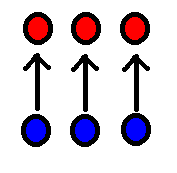
Stop (never hold) - The unit ceases movement.
Back - The unit moves backwards. Good Luck.
Slide Left - The unit moves to the left without any forward movement.
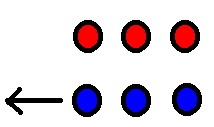
Slide Right - The unit moves to the left without any forward movement.
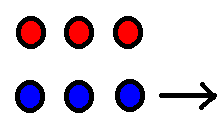
Oblique Left - The unit faces forward and moves at a 45 degree angle to the left.
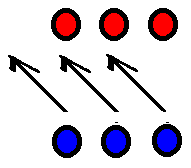
Oblique Right - The unit faces forward and moves at a 45 degree angle to the right.
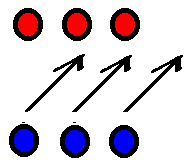
Lemon - The unit wraps around and caps the left side of the opposing unit.
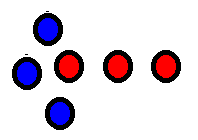
Rose - The unit wraps around and caps the right side of the opposing unit.
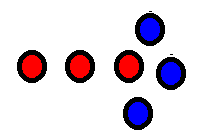
Charlie - The unit charges into the opposing unit. This is not recommended.
The maneuvers which appear in bold are the basic necessities.
What are some basic melee tactics?
Counter punch - React to what the opposing unit does. This does work, but it is not easy.
Rose - Advance the unit almost to the point of engagement then call for a rose.
Lemon - Advance the unit almost to the point of engagement then call for a lemon.
Double Envelopment
There are a multitude of ideas. Always try to keep your tactics simple, and do not expect them to survive engagement. "Get `em Ray" is never a good plan.
Where we can go from here?
From this point experiment and experience you will learn what works and what does not. Some of my favorites:
Atlantian Five Man Tourney - At this tourney, we broke a five person unit down into three pieces, two person units and a single person (Don Rian). We sent the single out in front, and they picked a side to go to. We then put the two larger parts out to either side and tried to ball them up.
Stacked Units - This was designed my Master John the Pell and Duke Hasdrubal of Ealdomere. Take two or three units and stack them in line towards the opposing side. The unit in front will be the slower one, and the fastest will be in the back. When lay on is called, the commander of the front unit picks where he should hit. This should be on a corner of the opposing unit.
The commander of the back unit now decides where they should hit. The choices being around the out of the front unit, attacking the same flank in support, hitting on the inside of the first unit to protect the flank, or hitting the other corner of the opposing unit, which will also protect the flank of the first unit but allows access to the opposing units back field.
Two Man Hit Teams - This is a variant of the Atlantian Five Man that Don Rian and I have been talking about. Two fencers per unit one fencer in command. If there is more than one group, they should work in support of each other. In this you can form lines like a traditional unit, but if you need to react to something, you can detach two fencers from the unit to deal with it.
If you would like to e-mail the author of this paper with questions and/or comments, you may contact him at yngvar@faerhaga.org.

SWORDandMUG









